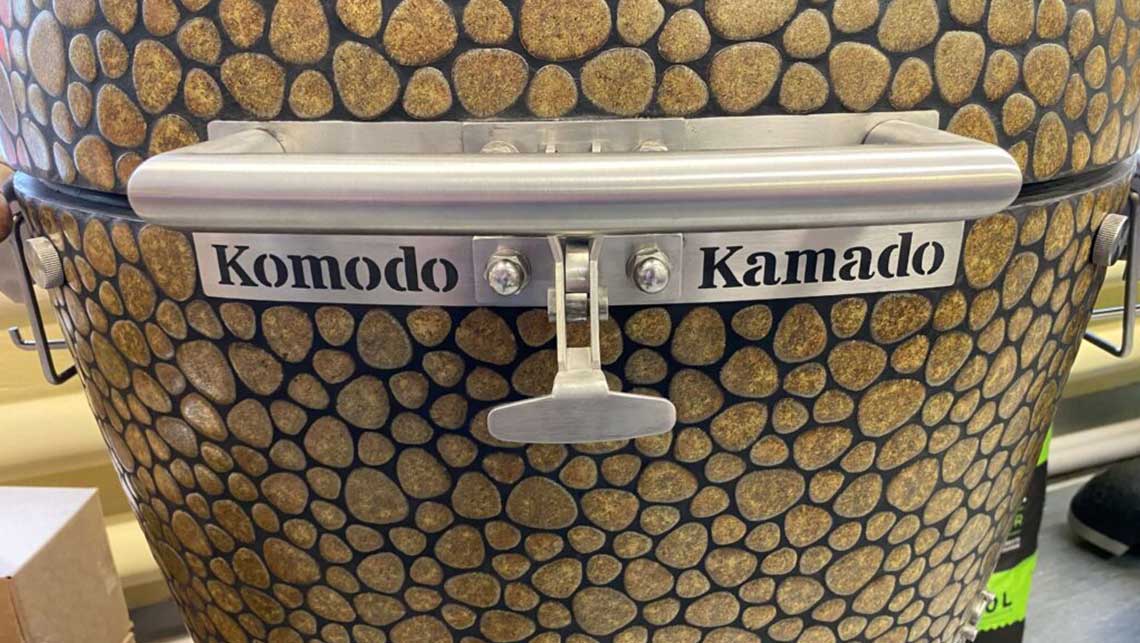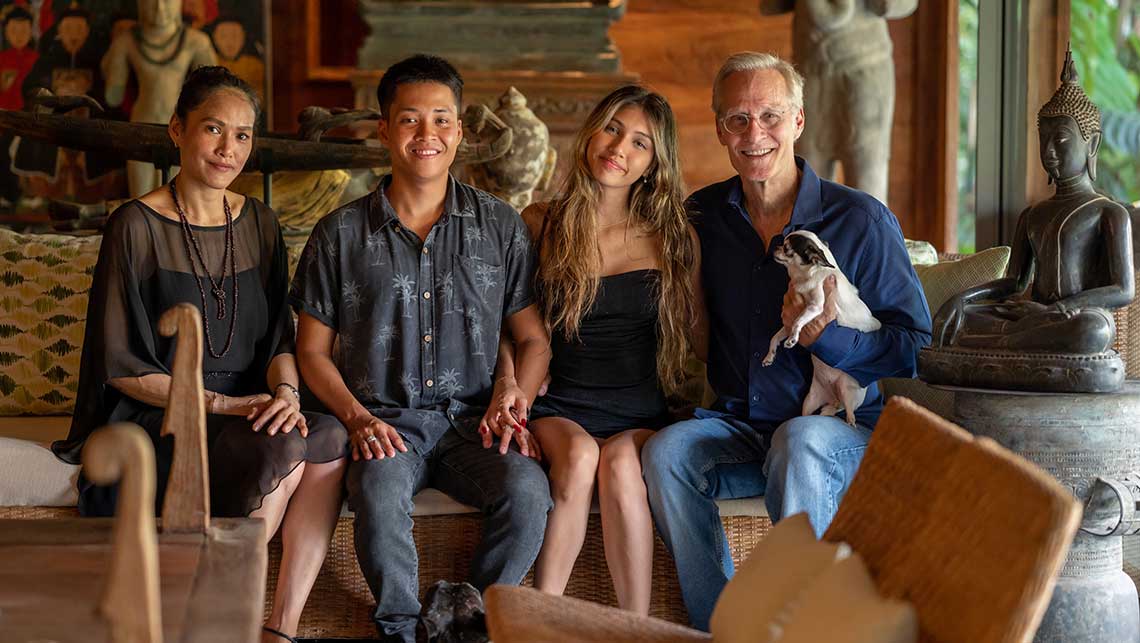Dennis Linkletter has spent an endless summer living in Indonesia handling high quality wood. today he makes the world’s best bbqs. go figure.

So Dennis, how did you come to live in Bali?
I was actually born in Hollywood CA but grew up in Laguna Beach. In 1978 after graduating from High School, I decided to take a year off before college and to recreate the trip shown in the Endless Summer surfing movie. For “self-discovery”, I told my parents. That brought me to Bali for the first time – it was also when I caught the Bali bug! Bali has a way of haunting your subconscious and pulling you back again and again. After school, I spent two years working in Europe and one year in New York before settling in Los Angeles. Then in the mid 80s, I found myself in Bangkok for a bachelor party and realized how close I was to Bali … next thing I knew, I was visiting again. While there, I was amazed at how inexpensive and beautiful the antiques were, so I bought half a dozen crates and sent them home. They were sold easily, and this started my import business.
I shipped my first container of antiques back to Los Angeles in 1987. As a woodworker by hobby, I would restore them in my Hollywood backyard using laborers at $8 an hour. It was a lot of work, but I could buy containers of antique teak benches in East Java for $20, have them landed and restored in LA for $50 and sell them for $350 and up. It was too good to be true. After a couple of years of flying back and forth, I realized that when I was in Los Angeles, I could not wait to get back to Bali, and when I was in Bali, I didn’t want to go home. And because the exchange rate was Rp.1,800 to the US dollar, talented Javanese carpenters were only $1 a day. This prompted me to sell everything I could not pack up, and move to Indonesia.
I set up a workshop in Surabaya, East Java, because that’s where the antiques were, and a home in Bali on Jl. Kayu Aya/Oberoi. I would stay in Bali Friday through Monday and Tuesday through Thursday in Surabaya, the flight is only 45 minutes, so this was easy. Life was good.
From 1991 to 2003, I designed and built furniture, which I shipped along with the antiques to my store in Los Angeles, Not So Far East Trading. We were the first large Indonesian furniture store in Southern California. We had 420 workers hand-building a container a week of mortise and tenon teak furniture using recycled teak. When a fire burned the factory to the ground, I realized it was time to move on. My woodworking business turned into a textured floors business which I still have to this day.

So how did you decide to build and sell Kamado grills?
So there was an unscrupulous guy building a similar kamado grill in Surabaya who got thrown out of the country, and his workers were left high and dry. Somebody told me about it and suggested that I look into it because I was the McGyver jack-of-all-trades type. After researching them online, I saw there was so much passion and buzz about kamado grills. It was like Apple Computer, Harley Davidson, and Marlboro cigarettes all rolled into one, and the BBQ industry was booming. So in August 2003, I decided to jump in and create my own version.
Woodworking was my bread and butter, but the grills were my passion. The grills were great because I love designing, building, and working on new projects. It was a huge undertaking expanding the line to seven models, and I continually pushed to the factory to improve overall quality and fit and finish. All the hard work paid off, and we received worldwide recognition in 2017 when Forbes magazine wrote a lengthy editorial saying we were the best-designed and built grills of any type on the market. (Google Forbes Komodo Kamado.) Since that moment, the grill factory and sales have been going strong. We literally ship them everywhere in the world, and have warehouses in Los Angeles and in the UK. We don’t sell wholesale or to any dealers. All sales are factory-direct through the website.
So that actually keeps your costs lower as you cut out the middleman.
Yes, factory-direct, wholesale to the public is our business model. In the last 20 years, e-commerce has, of course, exploded, and we’ve ridden the wave.
I’m guessing it’s not easy to get somebody to buy a $5,000 to $10,000 grill online. It’s a lot more than buying a pair of shoes, for instance.
Our reputation for unusually high-build quality paired with the grills being expensive yet a great value has put us alone in our niche. Twenty years of experience, customers’ word-of-mouth referrals, and scores of excellent reviews drive sales.
I also take calls personally. I work from 1am to 6am answering calls and then I sleep from 6am to 12 or 1pm. We’re in the process of making videos to replace these sales calls!
Tell us about your family . . .
I met my wife Saisuda in Thailand 23 years ago, and we’ve been together ever since. We have two children, Dexter and Isla.

Is the factory still in Surabaya?
Yes, it is. About 15 years ago, when the kids started going to school, we moved full-time to Bali for them so that they could go to an international school. Dexter graduated from Canggu School, and Isla still goes there.
So back to your grills, what sets Komodo Kamado apart?
Our motto is “overbuilt and over-engineered to last a lifetime”. The metalwork is 304 stainless steel, methods of fabrication include CNC laser cutting, CNC folding, and TIG welding. The precision of the fit and finish of the components were driven by my high standards for building furniture. It’s not something you usually see in a commercial product. The grills are revolutionary in materials, construction, and shape. We use blast furnace refractory cements and insulation, the same materials as every metal or glass blast furnace or nuclear facility, which makes them extremely durable. The insulation means you burn less fuel, this creates less airflow, which makes less evaporation which makes better BBQ. To give you an idea of how efficient they are, my largest grill with one basket of charcoal at 235ºf/113ºc will burn for 215 hours.
Where and who in Bali are using your grills?
The most well-known would be Joseph Antonishek at Karma Private Beach, Doudou from Metis, Gooseberry Restaurant, Bingin, The Forge in Petitenget, Black Sand Brewery in Batu Bolong and James Ephraim at Wooden Fish Village, Pantai Nyanyi. Although the grills have been my passion and my baby, I still do quite a bit of hotel work building wide plank teak flooring, wall and ceiling cladding. John Malkovich was my first flooring customer, and articles about his house initially drove sales.
My textured wide plank teak floors have no flat surfaces which easily absorb/hide typical nicks, dents and scratches, making them low maintenance and easy to repair.

These floors are unique in that they have hand-sculpted textures. In comparison, flat wood looks unnatural. We have three different textures, hand-hewn, Linear planed, made with a hand plane against the grain, and rain-washed to accentuate the wood’s grain by reducing the soft wood between the growth lines. They are then sealed using polymerized tung oil, it’s an “in” the wood – not “on” the wood finish. It’s not a plastic coating on the wood like polyurethane, that can be scratched up/damaged and tough to repair without refinishing the entire room.
They are specified by designers and contractors all over the world and continue to be a main part of the factory’s production. I’m a verified supplier for HBA/Hirsch Bedner Associates and have shipped over 35,000 m2 of wide teak floors to Four Seasons Hotel projects for them. That being said, I also regularly supply wall and ceiling cladding, boxed beams, and custom floors for residential projects both here in Bali and worldwide.
What’s the future, do you see yourself staying in Bali?
It’s been 45 years since I first visited at 18 years old. I was 29 when I moved here, and have now been here 34 years. Crazy to think I’ve been in Indonesia and Bali longer than I lived in the States. I’ve seen so many different versions of Bali over the years. There are new challenges to living here, and many of the old challenges have been solved. The secret for me is to focus on the best of Bali, the magic is still here. I’m still grateful every morning to have lived here for so long and to continue to live here. We just bought a beautiful old property in Umalas and plan to stay in Bali. I still love my work, but looking into the future, my son Dexter is being trained to take over Komodo Kamado, and I’ll have to settle for retiring with my wonderful wife and six dogs and working in my garden.
WA: +62 818 850 860
IG: @komodo_kamado
www.komodokamado.com